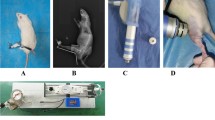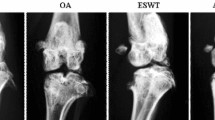Abstract
Introduction
The goal for treating osteoarthritis (OA) is finding ways to decrease joint pain and dysfunction and prevent and slow the cartilage degeneration. Extracorporeal shock-wave therapy (ESWT) has been found to improve motor dysfunction and ameliorate pain with OA in animals. However, few studies have found that it can prevent and slow joint degeneration in vivo. The aim of study was to investigate the effect of ESWT on OA in rabbit.
Materials and methods
A total of 30 male New Zealand white rabbits were divided into 3 groups: control, OA induced by anterior cruciate ligament transaction (ACLT), and ALCT plus ESWT. The animals were killed at 4 and 8 weeks. Nitric oxide (NO) level was measured in the synovial cavity of knee joints, and cartilage sections were graded macroscopically by a Mankin scoring system. Chondrocyte apoptosis was investigated by flow cytometry and the expression of active caspase 3 by indirect immunohistochemistry.
Results
ESWT significantly reduced the NO level in the synovial cavity of knee joints (P < 0.05) and chondrocyte apoptosis (P < 0.05) of rabbits with OA. ESWT treatment significantly decreased the severity of cartilage lesions at both times as compared to rabbits with OA alone (P < 0.05).
Conclusion
ESWT reduced the progression of OA in rabbits. This effect may be related to decreased level of NO and is likely mediated by reduced chondrocyte apoptosis. ESWT may be a useful treatment for knee OA.



Similar content being viewed by others
References
Shirai T, Kobayashi M, Nishitani K, Satake T, Kuroki H, Nakagawa Y, Nakamura T (2011) Chondroprotective effect of alendronate in a rabbit model of osteoarthritis. J Orthop Res 29(10):1572–1577. doi:10.1002/jor.21394
Hawker GA, Mian S, Bednis K, Stanaitis I (2011) Osteoarthritis year 2010 in review: non-pharmacologic therapy. Osteoarthr Cartil 19(4):366–374. doi:10.1016/j.joca.2011.01.021
Kim HA, Blanco FJ (2007) Cell death and apoptosis in osteoarthritic cartilage. Curr Drug Targets 8(2):333–345
van der Kraan PM, van den Berg WB (2012) Chondrocyte hypertrophy and osteoarthritis: role in initiation and progression of cartilage degeneration? Osteoarthr Cartil 20(3):223–232. doi:10.1016/j.joca.2011.12.003
Endres S, Weiskirch M, Hinz C, Hutter F, Wilke A (2008) Extracorporeal shock-wave therapy in the treatment of pseudoarthrosis: a case report. Cases J 1(1):276. doi:10.1186/1757-1626-1-276
Albert JD, Meadeb J, Guggenbuhl P, Marin F, Benkalfate T, Thomazeau H, Chales G (2007) High-energy extracorporeal shock-wave therapy for calcifying tendinitis of the rotator cuff: a randomised trial. J Bone Joint Surg Br 89(3):335–341. doi:10.1302/0301-620X.89B3.18249
Staples MP, Forbes A, Ptasznik R, Gordon J, Buchbinder R (2008) A randomized controlled trial of extracorporeal shock wave therapy for lateral epicondylitis (tennis elbow). J Rheumatol 35(10):2038–2046
Metzner G, Dohnalek C, Aigner E (2010) High-energy Extracorporeal Shock-Wave Therapy (ESWT) for the treatment of chronic plantar fasciitis. Foot Ankle Int 31(9):790–796. doi:10.3113/FAI.2010.0790
Frisbie DD, Kawcak CE, McIlwraith CW (2009) Evaluation of the effect of extracorporeal shock wave treatment on experimentally induced osteoarthritis in middle carpal joints of horses. Am J Vet Res 70(4):449–454. doi:10.2460/ajvr.70.4.449
Revenaugh MS (2005) Extracorporeal shock wave therapy for treatment of osteoarthritis in the horse: clinical applications. Vet Clin North Am Equine Pract 21(3):609–625. doi:10.1016/j.cveq.2005.09.001
Ochiai N, Ohtori S, Sasho T, Nakagawa K, Takahashi K, Takahashi N, Murata R, Moriya H, Wada Y, Saisu T (2007) Extracorporeal shock wave therapy improves motor dysfunction and pain originating from knee osteoarthritis in rats. Osteoarthr Cartil 15(9):1093–1096. doi:10.1016/j.joca.2007.03.011
Li X, Li J, Cheng K, Lin Q, Wang D, Zhang H, An H, Gao M, Chen A (2011) Effect of low-intensity pulsed ultrasound on MMP-13 and MAPKs signaling pathway in rabbit knee osteoarthritis. Cell Biochem Biophys 61(2):427–434. doi:10.1007/s12013-011-9206-4
Wang FS, Yang KD, Kuo YR, Wang CJ, Sheen-Chen SM, Huang HC, Chen YJ (2003) Temporal and spatial expression of bone morphogenetic proteins in extracorporeal shock wave-promoted healing of segmental defect. Bone 32(4):387–396 pii: S8756328203000292
Iwase Y, Kato J, Ohtaguro K (1989) Clinical experiences of Medstone 1050 ST on extracorporeal shock wave lithotripsy. Nihon Rinsho 47(12):2777–2780
Yoshioka M, Coutts RD, Amiel D, Hacker SA (1996) Characterization of a model of osteoarthritis in the rabbit knee. Osteoarthr Cartil 4(2):87–98 pii: S1063-4584(05)80318-8
Vaterlein N, Lussenhop S, Hahn M, Delling G, Meiss AL (2000) The effect of extracorporeal shock waves on joint cartilage—an in vivo study in rabbits. Arch Orthop Trauma Surg 120(7–8):403–406
Renz H, Rupp S (2009) Effects of shock waves on chondrocytes and their relevance in clinical practice. Arch Orthop Trauma Surg 129(5):641–647. doi:10.1007/s00402-008-0668-9
Benson BM, Byron CR, Pondenis H, Stewart AA (2007) The effects of radial shock waves on the metabolism of equine cartilage explants in vitro. N Z Vet J 55(1):40–44. doi:10.1080/00480169.2007.36733
Mayer-Wagner S, Ernst J, Maier M, Chiquet M, Joos H, Muller PE, Jansson V, Sievers B, Hausdorf J (2010) The effect of high-energy extracorporeal shock waves on hyaline cartilage of adult rats in vivo. J Orthop Res 28(8):1050–1056. doi:10.1002/jor.21074
Wang CJ, Weng LH, Ko JY, Wang JW, Chen JM, Sun YC, Yang YJ (2011) Extracorporeal shockwave shows regression of osteoarthritis of the knee in rats. J Surg Res 171(2):601–608. doi:10.1016/j.jss.2010.06.042
Ciampa AR, de Prati AC, Amelio E, Cavalieri E, Persichini T, Colasanti M, Musci G, Marlinghaus E, Suzuki H, Mariotto S (2005) Nitric oxide mediates anti-inflammatory action of extracorporeal shock waves. FEBS Lett 579(30):6839–6845. doi:10.1016/j.febslet.2005.11.023
Mariotto S, Cavalieri E, Amelio E, Ciampa AR, de Prati AC, Marlinghaus E, Russo S, Suzuki H (2005) Extracorporeal shock waves: from lithotripsy to anti-inflammatory action by NO production. Nitric Oxide 12(2):89–96. doi:10.1016/j.niox.2004.12.005
Moretti B, Iannone F, Notarnicola A, Lapadula G, Moretti L, Patella V, Garofalo R (2008) Extracorporeal shock waves down-regulate the expression of interleukin-10 and tumor necrosis factor-alpha in osteoarthritic chondrocytes. BMC Musculoskelet Disord 9:16. doi:10.1186/1471-2474-9-16
Abramson SB (2008) Nitric oxide in inflammation and pain associated with osteoarthritis. Arthr Res Ther 10(Suppl 2):S2. doi:10.1186/ar2463
Hancock CM, Riegger-Krugh C (2008) Modulation of pain in osteoarthritis: the role of nitric oxide. Clin J Pain 24(4):353–365. doi:10.1097/AJP.0b013e31815e5418
Li D, Wu Z, Duan Y, Hao D, Zhang X, Luo H, Chen B, Qiu G (2011) TNFalpha-mediated apoptosis in human osteoarthritic chondrocytes sensitized by PI3K-NF-kappaB inhibitor, not mTOR inhibitor. Rheumatol Int. doi:10.1007/s00296-011-1929-4
Acknowledgments
Project was supported by National Natural Science Foundation of China (No 31172169).
Author information
Authors and Affiliations
Corresponding author
Additional information
Z. Zhao and H. Ji contributed equally to this work.
Rights and permissions
About this article
Cite this article
Zhao, Z., Ji, H., Jing, R. et al. Extracorporeal shock-wave therapy reduces progression of knee osteoarthritis in rabbits by reducing nitric oxide level and chondrocyte apoptosis. Arch Orthop Trauma Surg 132, 1547–1553 (2012). https://doi.org/10.1007/s00402-012-1586-4
Received:
Published:
Issue Date:
DOI: https://doi.org/10.1007/s00402-012-1586-4




